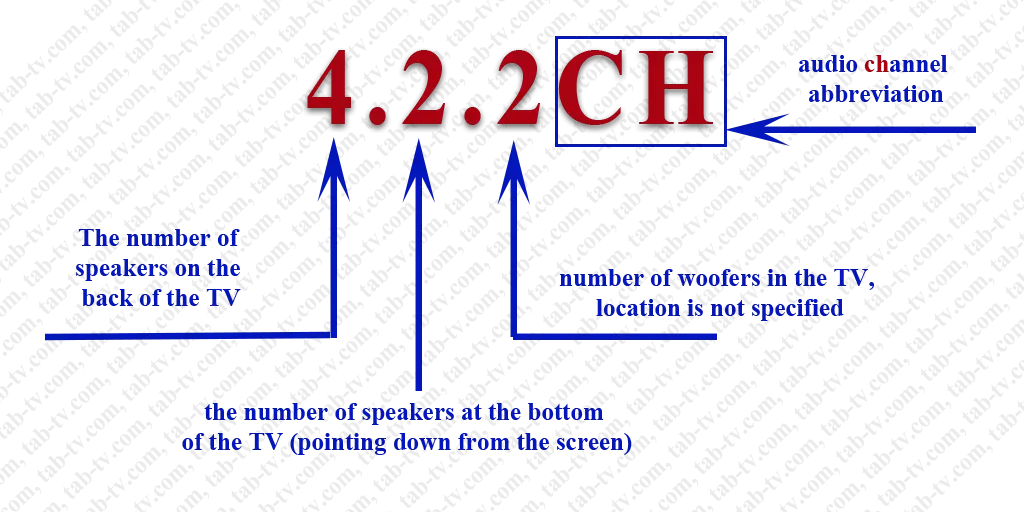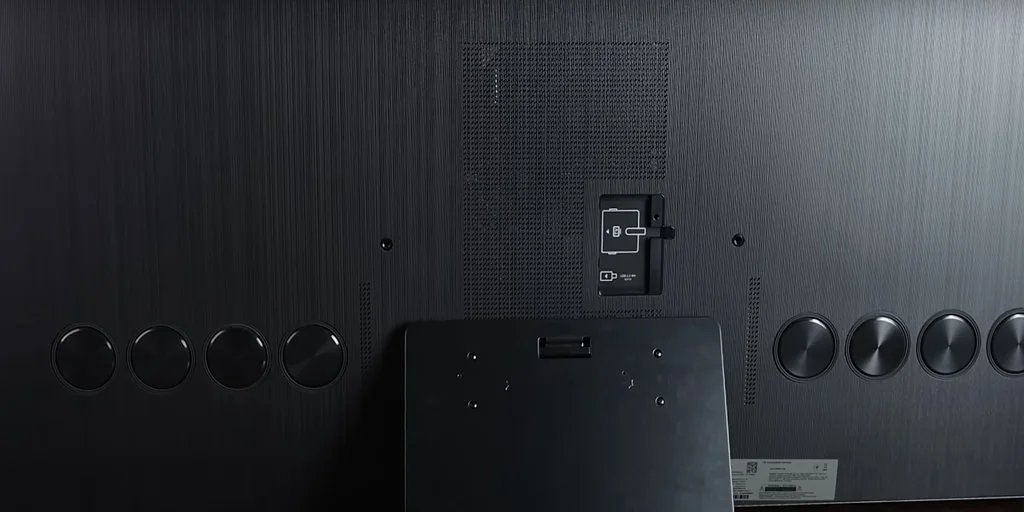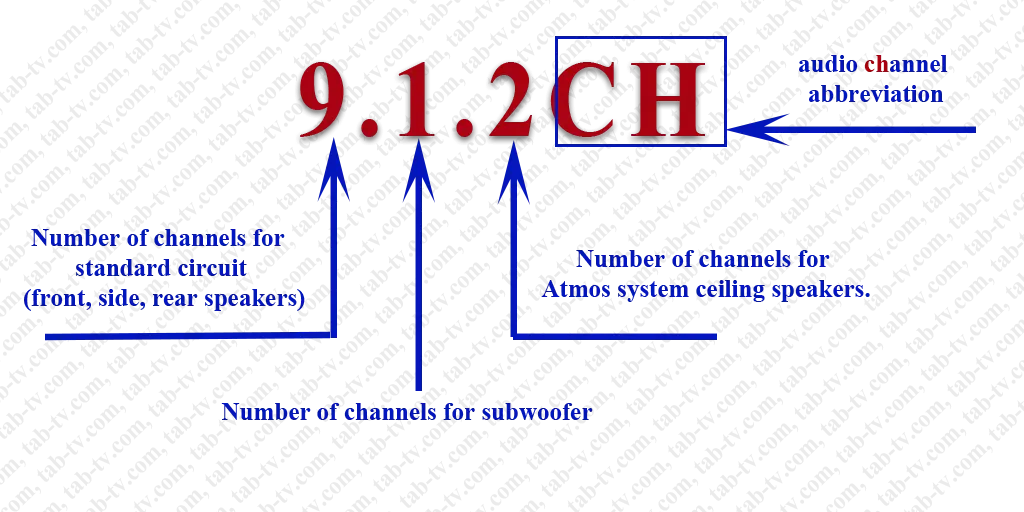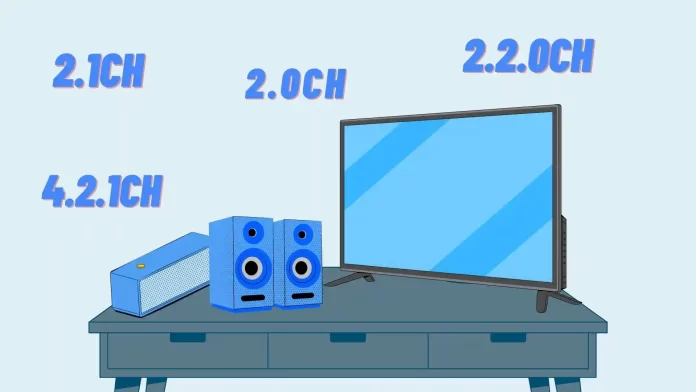If you look at the specifications of an audio device, such as a TV or soundbar, you will see the specification 2.0CH or 2.2.1CH. This abbreviation is used in several cases:
Speaker Type: Indicates how many speakers are installed in the device, their purpose, and their location. There is no standard for the number of supported speakers, but manufacturers follow standard practice.
Audio decoder: This designation is used in decoders to show how many audio channels the sound card digital processor can process, for example, Dolby Decoder MS12 5.1ch (you can decode this way, the decoder on the MS12 chip supports sound output in 5 audio channels and one subwoofer).
What CH stands for in TVs and other devices
CH (channel) is an acronym for the channel. For devices, it refers to the number of speakers in the device, which can correspond to the number of sound channels the device can play or vice versa. For example, CH2.0 means that the device has two speakers. This, of course, implies that such a device supports stereo sound. But a decoder in your TV can support external 5.1 speakers.
Number and type of TV speakers (4.2.2CH)

In TVs, the speakers are built into the TV itself, so the CH designation for TVs refers to the number of speakers and usually defines where they are on the TV.
Let’s take the QN900C TV speaker setup as an example using 6.2.4CH.
- 6 – The six audio speakers on the back of the TV.
- 2 – The two speakers pointing down at the bottom of the TV.
- 4 – The last digit represents the number of subwoofers. In this case, the TV has four subwoofers; their location is not specified. The location of the audio speakers can determine the location of the subwoofers. But, as a rule, the subwoofers are located at the bottom of the TV.
If we look at the picture of the QN900C, QN850C rear panel, we see eight speakers, 6 of them are audio speakers, and two are on the bottom, it remains to determine where the subwoofers are, and there are precisely two on the rear panel and two on the bottom of the TV.

Speaker Type formats in TVs
2.0 – two speakers
2.1 – two speakers and a subwoofer
4.1 – four speakers and a subwoofer
4.2 – four speakers and two subwoofers
2.2.1 – two rear speakers, two bottom speakers, subwoofer
2.2.2 – two speakers at the back, two at the bottom, two subwoofers
4.2.1 – four speakers at the rear, two at the bottom, subwoofer
4.2.2 – four rear speakers, two from the bottom, two subwoofers
6.2.2 – six rear speakers, two from the bottom, two subwoofers
6.4.2 – six rear speakers, four from the bottom, two subwoofers
6.2.4 – six rear speakers, two from the bottom, four subwoofers
CH in sound bars, home theater (number of channels)
In-home theater systems, CH usually refers to the number of channels the speaker generates.
There are two parameters in home theater specifications. Consider the Q-series 9.1.2 ch. / HW-Q910C.
9.1.2CH is the number of channels.
Numder speakers – this system has 17 speakers. Why so? One channel can have multiple speakers (midrange and treble) for better sound.
Decoding the 9.1.2CH home theater format.

This soundbar supports 12 channels of sound.
- 9 is the number of channels for the classic circuit. These channels provide sound from the front side and rear speakers.
- One is the number of channels for the subwoofer, usually one channel, but there can be several subwoofers.
- 2 – the number of overhead speakers pointing upwards in a home theater. In professional acoustics, the speakers are located on the ceiling.
Audio systems by number of channels
The standard arrangements are as follows:
- 2.0 audio format – standard format – 2 speakers left-right.
- 2.1 audio format – 2 speakers + subwoofer
- 3.1 audio format – 3 speakers (front, left, right) and a subwoofer.
- 5.1 audio format – 5 speakers (front, front left, front right, rear left, rear right) + subwoofer
- 7.1 audio format – 7 speakers (front, front left, front right, rear left, rear right, and two rear speakers) + subwoofer.
- 7.1.2 audio format – 7 speakers (front, front left, front right, rear left, rear right, and two more rear) + subwoofer + two directional upward speakers for Atmos.
- 7.2 audio format (front, front left, front right, rear left, rear right, and two more rear.) + subwoofer.
- 9.1 audio format – 9 speakers (front, front left, front right, corner front right, corner front left, rear left, rear right, and two more rear) + subwoofer.
- 9.1.2 audio format – 9 speakers (front, front left, front right, corner front right, corner front left, rear left, rear right, as well as two more rear speakers) + two outboard speakers + subwoofer.
- 11.1 audio format – extended format, channels are separated vertically.
There are other formats, but they are less common. Many companies are developing sound formats like Atmos or DTS. But the principle is the same everywhere; to create surround sound, the sound has to spread out from the front to the sides and back. This is the basis for creating surround sound. Also, remember that to properly create surround sound, the original audio format must contain the necessary sound channels. The system will generate pseudo surround sounds if they are not in the audio stream.





